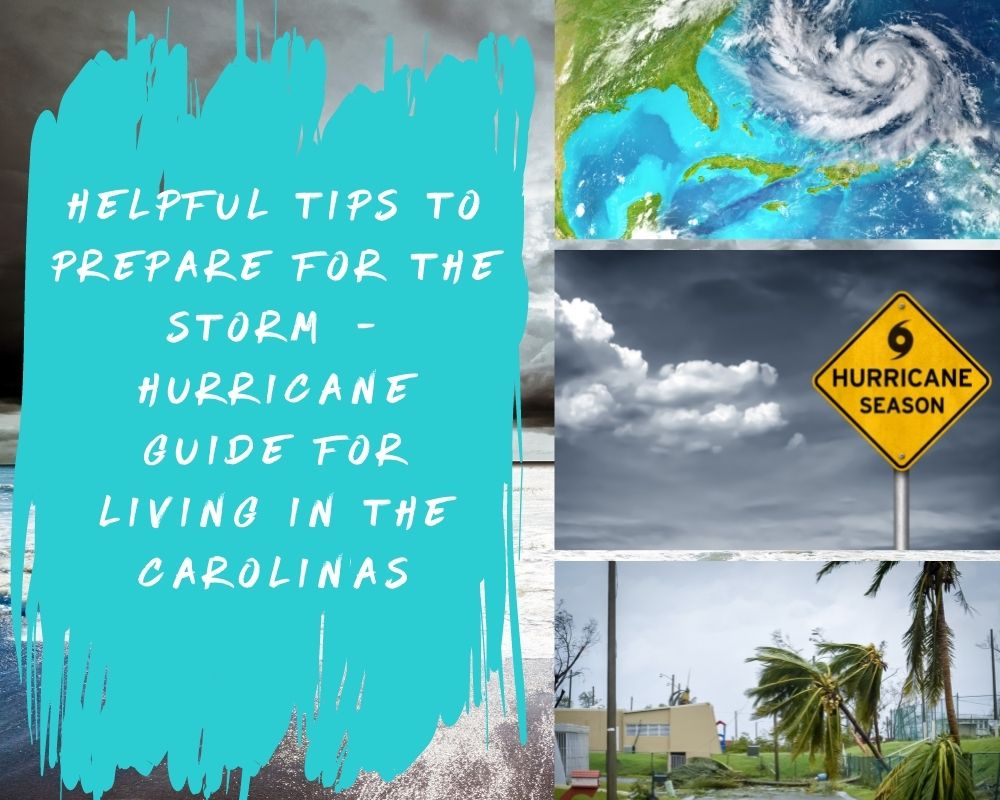Helpful Tips to Prepare for the Storm | Hurricane Guide for Living in the Carolinas

Helpful Tips to Prepare for the Storm – Hurricane Guide for Living in the Carolinas
Perhaps you’ve recently found your dream home and moved to an area in the Carolinas, or maybe you’ve lived here for some time but haven’t encountered a hurricane yet. Well, it won’t be long until you experience one, since hurricanes are quite a common occurrence here on the East Coast. To give you an idea of just how many hurricanes hit our country, here is a list of the top ten states by hurricane landfalls.
Top 10 States by Hurricane Landfall
1. Florida
Since record-keeping began in 1851, an alarming 120 hurricanes have hit Florida, where 37 of these registered as Category 3 or higher. The last major hurricane to make landfall on The Sunshine State was Category 5 Hurricane Michael from 2018.
2. Texas
Since 1851, the Lone Star State has been struck by hurricanes 65 times, where almost a third of those registered as Category 3 or higher. Hurricane Laura was the last hurricane that the state saw, which was back in August 2020.
3. North Carolina
In the past 170 years, North Carolina has lived through 57 hurricanes. However, only seven of them were classified as Category 3 or higher. The last hurricane to ravage the state was Hurricane Dorian, leaving more than 15 inches of rain and almost 200,000 people without power in its wake.
4. Louisiana
Since Louisiana is right next to Texas, it also experiences a big share of hurricanes, although much less compared to its neighbor. Since official record-keeping began, the state has recorded a total of 56 hurricanes, with the most recent being Hurricane Laura during the summer of 2020.
5. South Carolina
This state has come face to face with 30 hurricanes since 1851. And while Hurricane Dorian never made it to the mainland, its winds and rain did leave an impact in South Carolina in 2019.
6. Alabama
Since the mid-1800s, Alabama has witnessed 24 hurricanes come and go. However, only three of these were Category 3 or higher. While tropical storms have struck the state in recent years, the last hurricane to leave a devastating impact was still Katrina.
7. Georgia
According to records, the Peach State has seen 22 hurricanes. Hurricane Michael was the last hurricane to hit Georgia, which brought wind gusts as fast as 115 mph aligned with a deluge of rain in 2018.
8. Mississippi
In the past 170 years, a total of 19 hurricanes have struck Mississippi, but only eight were classified as Category 3 or higher. The last hurricane to have a significant impact on the state was Hurricane Laura in August of 2020.
9. New York
While New York is located far north, it still gets a surprising amount of hurricanes. Since 1851, a total of 15 hurricanes have struck the state since 1851. Even more surprising is that three of these were a Category 3 or higher. Hurricane Sandy was the most severe, causing damages amounting to billions of dollars and killing almost 50 people in 2012.
10. Massachusetts
Since the mid-1800s, 12 hurricanes have left their mark on Massachusetts, but only one was a Category 3 or higher. While Hurricanes Florence and Michael tried to enter the state, they only reached the Cape Cod region. As a result, no hurricane has made landfall in Massachusetts in nearly 30 years.
The Hurricane Scale
Hurricanes are known as a powerful tropical weather system that usually affects the Carolinas from June 1 to November 30. However, the peak season occurs between mid-August to late October. Tornadoes, heavy winds, flooding, strong thunderstorms, landslides, flooding, and storm surge may all be products of hurricanes.
The Saffir-Simpson Hurricane Wind Scale provides an estimate of the potential property damage as calculated by a hurricane’s wind speed. A hurricane that reaches Category 3 or higher is expected to have a devastating impact, due to its potential for significant property damage and loss of life. However, storms that are classified as Category 1 and 2 are still dangerous and will need preventative measures. Here are hurricane categories according to the Saffir-Simpson Hurricane Wind Scale:
- Tropical Depression: Winds up to 39 miles per hour (mph)
- Tropical Storm: 39 to 73 mph winds
- Category 1: 74 to 95 mph winds
- Category 2: 96 to 110 mph winds
- Category 3: 111 to 129 mph winds
- Category 4: 130 to 156 mph winds
- Category 5: Winds 157 mph or greater
History on Hurricanes
Historically, the autumn months have been known as the peak of hurricane season in the Carolinas, where 60% of all hurricanes occur during September and October. Some of the most devastating hurricanes have occurred during this time. Here are some of the most notable to have hit the state, from the earliest to the most recent occurrence.
Hurricane Hazel — October 15, 1954
Making landfall on this date, Hurricane Hazel entered the North and South Carolina border. At the time, the storm surge it created was some of the worst ever recorded in North Carolina. An overwhelming storm surge of between 12 to 18 feet affected a huge part of the coastline, resulting in catastrophic high tide.
Hurricane Gracie — September 29, 1959
For a few years, Hurricane Gracie was the last major hurricane to have a big impact on South Carolina. Later studies were able to confirm that Gracie was a Category 4 storm that barreled through the state with winds of over 130 mph. During her onslaught, ten lives were claimed in South Carolina and Georgia.
Hurricane Diana — September 29, 1984
While Hurricane Diana officially became a hurricane on September 10th, it took a few days to make landfall at Wilmington, North Carolina. It had sustained winds of 100 mph, and had a unique path — it made a loop back to North Carolina, adding more heavy rain to the already flooded areas of the state.
Hurricane Hugo — September 22, 1989
The strongest hurricane to ever reach Carolina’s lands, Hurricane Hugo had peak winds of around 135-140 mph, devastating Charleston, South Carolina and its surrounding areas. This storm caused 20-feet high tides along the coast, and its sheer speed made sure that it also made landfall across much of the state, including Charlotte.
Hurricane Floyd — September 16, 1999
On this day, Hurricane Floyd made sure its presence was felt through a 10-15 foot storm surge (however the peak was around 18 feet.) This storm hit at over 110 mph as a Category 2 storm along the Carolina Coast. Much of North Carolina was left with more than 20 inches of rain as Floyd continued north.
Hurricane Matthew — October 8, 2016
When Hurricane Matthew reached South Carolina, it continued to follow a slow path along the coast. While Matthew was a weak Category 1 hurricane, it was better known for its capability in flooding rather than wind speed. At the time, Hurricane Matthew was deemed to be a Category 1 in a 1000 year flood.
Hurricane Florence — September 14, 2018
The title for the most rain dumped in North Carolina from a tropical storm was taken from Floyd by Hurricane Florence. This hurricane peaked at Category 4 but started as Category 1 in Wilmington, NC. It was also responsible for holding the record of flooding streets all the way to Charlotte.
Understanding Storm Surge and the Dangers with Water and Flooding
Before worrying about preparing for any upcoming storms, it’s best to first get an understanding of important terms related to hurricanes. A storm surge is created when water is pushed to the shore due to the forces of wind. This results in a rise in water which then causes extreme flooding. Storm surges are often the biggest threat to our homes and lives, especially for those who live along coastal areas.
When tropical storms reach land, they often produce heavy rain everywhere and can result in destructive and deadly flash floods, as well as long-term flooding of the area. However, the amount of rainfall isn’t related to the strength of the storm but is instead dependent on the size, speed, and the area geography. It’s also worth mentioning that should you encounter a flooded roadway, it’s never worth driving through it — just turn around and stay safe.
Do Not Panic
One of the most important things to keep in mind is to never panic, which applies before, during, and after the storm. You will provide yourself with an advantage if you create a plan ahead, rather than leaving things to the last minute. One of the best things you can do ahead of time is to create an emergency kit, whether you decide to evacuate or if you choose to ride the storm out.
It’s also important to stock up on enough supplies in your home that will cover the needs of your family for the next three days. Be sure to assemble a Family Emergency Kit full of things you’ll need in the event of an evacuation or emergency. Ensure that your supplies are stored in an easy-to-carry container that’s sturdy, such as a duffle bag, covered storage container, or suitcase. Here’s a checklist that you can use to keep track of your items.
- Two gallons of water per person every day for the next three days to use for drinking and sanitation.
- Non-perishable food for the next three days
- A hand crank or battery-powered radio along with an NOAA Weather Radio and extra batteries
- A first aid kit
- Flashlight with extra batteries
- Garbage bags, moist towelettes, and plastic ties for personal sanitation
- A whistle to signal for help
- A can opener for food
- Cell phone with chargers
- Local maps
- Infant formula and diapers
- Pet food and extra water if you have pets
- Essential documents such as identification, bank account records, and insurance policies should be separated in a waterproof and portable container.
- Cash or traveler’s checks and change
- Family emergency contact information
Water Needs
- Be sure to store water in plastic containers like plastic milk jugs or soft drink bottles.
- Don’t use containers that may break such as glass bottles.
- Keep in mind that an active person needs to drink a minimum of two quarts of water per day. However, children, nursing mothers, and those with illness will need more.
- Keep a minimum of a three-day supply of water for everyone in the family.
Food Needs
- Bring foods that don’t need to be refrigerated and those that need little preparation or cooking.
- Bring food items that are lightweight and compact.
- Choose ready-to-eat canned meats, vegetables, and fruits.
- Bring staples such as salt, sugar, and pepper.
- High energy foods such as trail mix, crackers, peanut butter, jelly, and granola bars
- Vitamins
- Food items for elderly persons, infants, or those on a special diet
- Comfort food such as hard candy, cookies, lollipops, instant coffee, or tea bags
First Aid Kit
- Remember to assemble a kit for your home and one in each car, and be sure to get a first aid manual from your local American Red Cross chapter. Each first aid kit should include the following:
- 2-inch sterile gauze pads (4-6)
- 4-inch sterile gauze pads (4-6)
- Hypoallergenic adhesive tape
- Triangular bandages (3)
- 2-inch sterile roller bandages (3 rolls)
- 3-inch sterile roller bandages (3 rolls)
- Scissors
- Tweezers
- Needle
- Moistened towelettes
- Antiseptic
- Thermometer
- Tongue blades (2)
- Tube of petroleum jelly or another lubricant
- Assorted sizes of safety pins
- Cleansing agent/soap
- Latex gloves (2 pair)
- Sunscreen
Other Items To Consider
- A change of clothing that includes sturdy shoes, long pants, and a long-sleeved shirt.
- A warm blanket or sleeping bag for every person.
- Bring additional clothing if you live in an area with a cold climate.
- Multipurpose tool
- Fire extinguisher
- Matches
- Duct tape
- Feminine supplies and personal hygiene items
- Dust mask if there is contaminated air
- Paper and pencil
- Books, games, puzzles, or other activities
- Mess kits, paper cups, plates, and plastic utensils
Preparing Your Home
There are a few things that you can do today to avoid headaches tomorrow, should the unexpected happen. Here is a guideline on things that you can do before a hurricane comes, along with items that you will need to keep on hand to give yourself an advantage during a storm.
Check Home Owners Insurance Policy
At a minimum, you must have full replacement cost coverage, which means that your home can be replaced up to the limit that’s been specified on the policy. The guaranteed replacement cost coverage will be able to pay all costs associated with rebuilding your home, even if it exceeds the policy’s limit. Here are other things you can do to ensure you get the most out of your insurance:
- Check for changes in codes.
- Update your policy to include the replacement of your possessions.
- Check your insurance policy for a windstorm or hurricane deductible.
- Find out if food is covered.
- If applicable, buy renter’s insurance.
- Consider purchasing flood insurance.
Create a Home Inventory
Doing this will allow you to keep track of everything in your home and ensure that everything is covered under your policy.
- Make a list of all valuables and furniture — make sure to document them by taking pictures or making videos of your belongings.
- Make use of tools such as the MyHomeScr.app.book app to help you log a comprehensive list of all your possessions for electronic safekeeping.
- Another step towards keeping your possessions safe is to place important items inside a watertight bag and store it in a fireproof safe or safe deposit box.
- Make copies of all your government-issued identifications such as Passports, Social Security cards, and drivers licenses for all family members.
- Make copies of medical records for every family member.
- Make copies of wills, birth certificates, marriage certificates, and other important legal documents.
Know Your Zone
Before a disaster like a hurricane strikes, be sure to get online and get to know your flood and evacuation zone. Whether you’re a resident or a visitor, it’s important to learn about evacuation zones, as well as how they will hold up against storm surges. Visit the South Carolina Emergency Management Division website to learn more about safe zones through their interactive map.
Pets
If you have, be sure to take the necessary steps below to ensure their survival during a hurricane. Remember, pets are part of the family too, so they shouldn’t be left behind. There’s no better time to start preparing than now, so be sure to remember the following.
ID Your Pet
Ensure that your cats and dogs have collars or identification tags that will help others trace them back to you. Doing this will increase your chances of reuniting with your pets should they get lost or separated from you, but you can also look into having them microchipped. Another thing you can do is to leave your phone number on your pet’s tag, and you may even leave a relative’s number to help with your pet’s safe return.
Always Take Your Pet During Evacuation
Remember that if a place isn’t safe for you, then it’s not safe for your pets. Because you don’t know just how long you’ll be away from your home, you may not be able to go back for your pets. A pet that’s left behind in a disaster can become lost, injured, or killed. Be sure to make plans for every pet, to ensure that every pet, whether it’s a cat, dog or horse is safe.
It also helps to evacuate early when you have pets — don’t wait for an evacuation order. Unfortunately, those who wait to be evacuated by emergency officials may be told to leave pets behind, to make room for more people. Furthermore, the sound of thunder, high winds, and the smell of smoke may make pets afraid, which will make it difficult to load them into a carrier or crate. Getting out before conditions become severe will help to keep everyone safer and the situation less stressful.
Seniors and Disabled
Apart from the recommendations made above, there are various items specific for our elderly and disabled family members which also need to be included in your kit. These items include:
- Medications
- Medical Equipment such as:
- Batteries for hearing aids
- Spare pairs of glasses
- Spare dentures
- Spare oxygen tanks
- Equipment for monitoring blood sugar and blood pressure
- Medical Documents such as:
- Basic information like your blood type, any allergies you have, and a list of any conditions
- An outline of the treatments needed
- Information about medical equipment needs
- A list of prescriptions along with the dosages
- A list of contact information for physicians
- Copies of Medicare, Medicaid, and other insurance information
- Documentation for service animals if applicable
Landscaping to Protect Your House
There’s no doubt that preparing your home ahead of strong winds and high waters can be difficult; there are a few things that you can do to ensure that the damage is minimized. However, keep in mind that this needs to be done every year, not just at the last minute to maximize results.
- Choosing salt-tolerant greenery
- Planting the right trees in the right location
- Pruning your plants properly
- Using soft mulch
- Removing storm hazards
Preparing Your Business for a Hurricane
Disasters can be a scary thought, especially if you have a business you’re trying to start. Perhaps your business is already established, and you’re not sure of how you can protect it from such an event. Understandably, the fear of incurring huge financial costs when trying to rebuild your business after a hurricane is enough to drive anyone crazy.
However, you will be in a better position to recover and keep your operation going if you plan ahead of time. Here’s a step-by-step process on how you can protect your business from emergencies such as hurricanes. You may also check a more comprehensive list here.
- Assess your risk.
- Create a plan.
- Practice your plan with staff.
- Execute your plan.
- Get financial assistance.
Getting Back to Business
There are many steps to the business or organization reentry process, but this can be done easily if you’ve prepared accordingly. Here’s what you need to do after the hurricane has passed when you want to get back up and running. You may also check out this PDF to get a more detailed breakdown of this process.
- Contact your insurance provider, and file your claim.
- Register with FEMA.
- Contact BLNC (Business Link North Carolina).
- Visit the business recovery website, SBTDC (Small Business and Technology Development Center).
- Speak to a business counselor.
- Apply for a business recovery loan.
- Consider filing for unemployment claims and benefits.
- Make use of the NCDOA HUB Database.
Evacuation Routes
Several major highways and interstates that go to and from North Carolina can accommodate heavy amounts of traffic. They also have higher speed limits that allow drivers to evacuate from threatened areas immediately. Evacuation routes are also more efficient compared to using local roads. Here are links that you can refer to for the state of Carolina:
Shelters
When a hurricane is present, shelters around the state open up and offer a safe area for those who wish to evacuate. You may get more details and the locations of various shelters via these links:
Furthermore, should a federal disaster be declared, federal assistance for individuals will become available, and survivors who incur damage to their home may be eligible for the following:
- FEMA housing solutions
- Rental Assistance
- Transitional Sheltering Assistance
- Home Repairs
- Direct Temporary Housing
Making Your Way Back Home
After the storm has passed, and you feel the need to go back home, don’t do so in a hurry. Instead, be aware that some areas may be inaccessible even after evacuation orders are no longer in place. Be sure to do the following:
- Always follow directions.
- Keep a lookout and stay vigilant.
- Carefully inspect your home and its surroundings.
- Dispose of debris from the storm.
- Assess if the water in your home can be used and consumed safely.
Going through a catastrophe like a hurricane is not an easy task, much less having everything kept the way you left it. However, if you religiously follow the steps and guides above, you should be able to come out of such a disaster relatively unscathed. Just be sure to account for everything and everyone (including pets) in your home, keep an organized and complete list of all your belongings, and make sure that you have a copy of everything important. Preparing ahead of a hurricane will ensure that you don’t have to go through more difficulties down the road while keeping everyone safe at a time of stress and panic. Print off our EZ Home Search Safety Checklist so you can be prepared for the upcoming hurricane season!
Start Your Home Search
Preston Guyton
Share this Post
Related Articles
Real Estate Tips
How to Communicate Your Value As A Real Estate Agent
Real Estate Tips
10 Essential Steps to Hiring a Contractor
Real Estate Tips
Why Perfection Squashes Your Real Estate Businesses
Real Estate Tips





